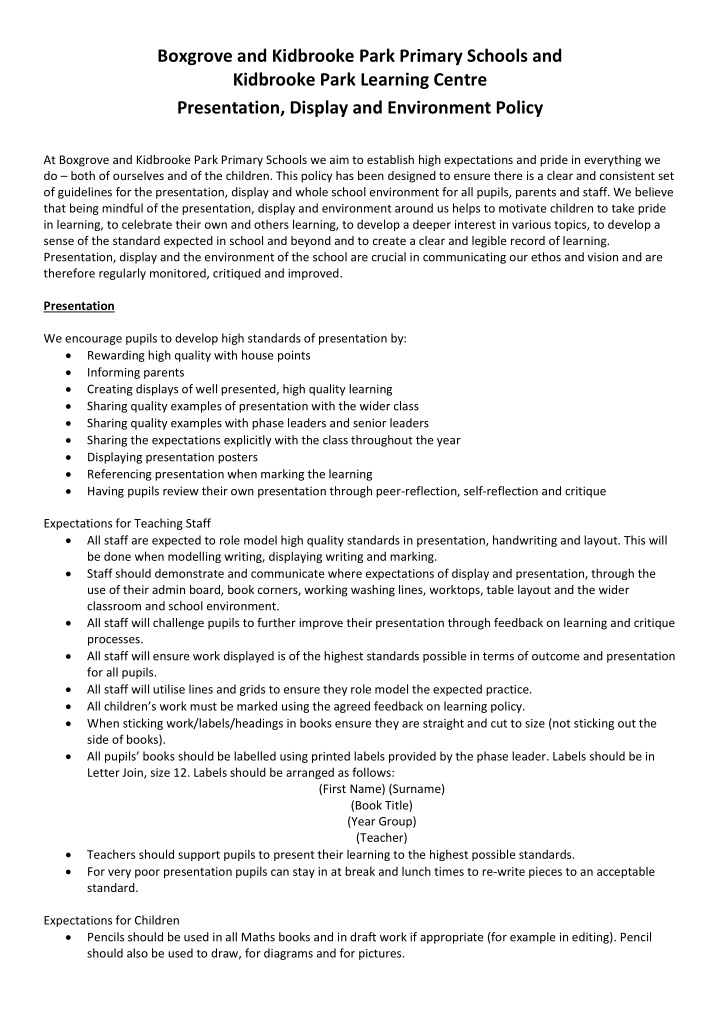



Boxgrove and Kidbrooke Park Primary Schools and Kidbrooke Park Learning Centre Presentation, Display and Environment Policy At Boxgrove and Kidbrooke Park Primary Schools we aim to establish high expectations and pride in everything we do – both of ourselves and of the children. This policy has been designed to ensure there is a clear and consistent set of guidelines for the presentation, display and whole school environment for all pupils, parents and staff. We believe that being mindful of the presentation, display and environment around us helps to motivate children to take pride in learning, to celebrate their own and others learning, to develop a deeper interest in various topics, to develop a sense of the standard expected in school and beyond and to create a clear and legible record of learning. Presentation, display and the environment of the school are crucial in communicating our ethos and vision and are therefore regularly monitored, critiqued and improved. Presentation We encourage pupils to develop high standards of presentation by: Rewarding high quality with house points Informing parents Creating displays of well presented, high quality learning Sharing quality examples of presentation with the wider class Sharing quality examples with phase leaders and senior leaders Sharing the expectations explicitly with the class throughout the year Displaying presentation posters Referencing presentation when marking the learning Having pupils review their own presentation through peer-reflection, self-reflection and critique Expectations for Teaching Staff All staff are expected to role model high quality standards in presentation, handwriting and layout. This will be done when modelling writing, displaying writing and marking. Staff should demonstrate and communicate where expectations of display and presentation, through the use of their admin board, book corners, working washing lines, worktops, table layout and the wider classroom and school environment. All staff will challenge pupils to further improve their presentation through feedback on learning and critique processes. All staff will ensure work displayed is of the highest standards possible in terms of outcome and presentation for all pupils. All staff will utilise lines and grids to ensure they role model the expected practice. All children’s work must be marked using the agreed feedback on learning policy. When sticking work/labels/headings in books ensure they are straight and cut to size (not sticking out the side of books). All pupils’ books should be labelled using printed labels provided by the phase leader. Labels should be in Letter Join, size 12. Labels should be arranged as follows: (First Name) (Surname) (Book Title) (Year Group) (Teacher) Teachers should support pupils to present their learning to the highest possible standards. For very poor presentation pupils can stay in at break and lunch times to re-write pieces to an acceptable standard. Expectations for Children Pencils should be used in all Maths books and in draft work if appropriate (for example in editing). Pencil should also be used to draw, for diagrams and for pictures.
Margins in books and on paper should be drawn in pencil if required (Numeracy books in KS2) . Pencil should be used for written work in EYFS and KS1. Pens should be used for written work as soon as possible from Year 3 onwards. Pens must be school provided, blue ink, fibre tipped handwriting pens. No ballpoint, biros or felt pens should be used. Felt pens should not be used in exercise books for underlining or illustrations although they can be used on paper at the teacher’s discretion. Pupils should always aim to present their learning to the highest possible standards. Pupils should take pride in their own appearance and that of the wider school environment and should impact upon everything they do. Expectations for Handwriting The Letter Join scheme is the agreed scheme for teaching handwriting. Letter Join font is the preferred style for all worksheets and hand-outs. Use the right size letters when you need to – capital letters at the start of sentences and for proper nouns. Handwriting is made explicit in each class timetable Expectations for Layout For children in Reception and Key Stage One the learning intention is provided on a strip of paper for them to stick into their books (this is also done for SEN pupils in KS2). In Key Stage 2, the long date (in Maths the short date) is written at the top on the left hand side of the page; the Learning Intention on the next line. The date and Learning Intention must be underlined in pencil using a ruler. Miss a line under the LI and start at the margin. Every new piece of work begins on a new page. Leave one line between each paragraph. When mistakes are made, draw one neat line through the mistake and start again – do not overwrite. Write on the line. Do not write in the margin. Layout in Mathematics The short date and the LI should be underlined. If appropriate, pages can be divided into two with a ruled line. All figures must be written neatly and clearly with one figure to each square. Where pupils are writing their reasoning or explanation they do not need to place each letter in the square, using the horizontal lines as a guide. Each calculation must be clearly numbered with the number in the margin to distinguish it from working figures. There should be at least one clear square between each calculation, both horizontally and vertically. When using vertical layout, the answer should have ruler lines above and below an answer with the operation sign to the left or right in a separate column. Calculations which involve ‘carrying’ should see the relevant digit written smaller than usual beneath the bottom line.
Recommend
More recommend